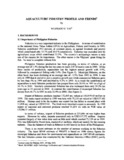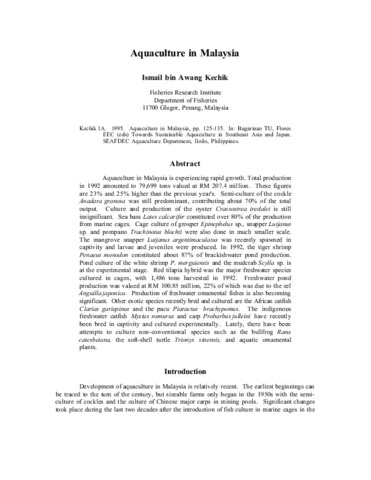Management strategies for grow-out culture of mud crab
- Global styles
- MLA
- Vancouver
- Elsevier - Harvard
- APA
- Help

Date
2017Author
Page views
19,785ASFA keyword
AGROVOC keyword
Taxonomic term
Metadata
Show full item record
Share
Abstract
There is an increasing interest in mud crab farming because of the growing demand for mud crab in domestic and international markets. Different methods for rearing crabs in ponds, pens and cages have evolved through several years of research and experiences of farmers. Mud crabs are cultured in brackishwater earthen ponds and pens in mangroves. Fattening of lean crabs is also integrated with the grow-out culture system. Cannibalism is one of the major factors affecting the survival of crabs in growout ponds and pens. Hence, various strategies are recommended to reduce cannibalism such as stocking density of less than 2,000 crabs ha-1, provision of suitable shelters, sufficient quantity of natural food and formulated feeds that are evenly distributed in the pond or pen. Feeding rate used in the pen is adjusted to avoid excess feeds that can attract rats and other land animals that can damage the enclosures. Selective harvesting is normally practiced since mud crabs do not grow or get fattened at the same time even if they belong to the same batch.
Suggested Citation
Genodepa, J. G. (2017). Management strategies for grow-out culture of mud crab. In E. T. Quinitio, F. D. Parado-Estepa, & R. M. Coloso (Eds.), Philippines : In the forefront of the mud crab industry development : proceedings of the 1st National Mud Crab Congress, 16-18 November 2015, Iloilo City, Philippines (pp. 22-27). Tigbauan, Iloilo, Philippines: Aquaculture Department, Southeast Asian Fisheries Development Center.
Type
Conference paperISBN
9789719931072Collections
Related items
Showing items related by title, author, creator and subject.
-
Aquaculture industry profile and trends
Yap, Wilfredo G. (University of the Philippines Aquaculture Society, Inc., 2001) -
Aquaculture in Malaysia
Kechik, Ismail bin Awang. (Aquaculture Department, Southeast Asian Fisheries Development Center, 1995)Aquaculture in Malaysia is experiencing rapid growth. Total production in 1992 amounted to 79,699 tons valued at RM 207.4 million. These figures are 23% and 25% higher than the previous year's. Semi-culture of the cockle ... -
Coastal aquaculture in Thailand
Sahavacharin, Songchai (Aquaculture Department, Southeast Asian Fisheries Development Center, 1995)Coastal aquaculture in Thailand has expanded rapidly in both area and production in the last decade. The important cultured species are the shrimps (Penaeus monodon and P. merguiensis), sea bass Lates calcarifer, groupers ...






